USS Abraham Lincoln (CVN-72) aircraft carrier underwent repairs and upgrades
Recall that the USS Abraham Lincoln (CVN-72) aircraft carrier, the fifth ship of the Nimitz type, was ordered in the 1982 year and laid down at the end of the 1984. Launching took place in February 1988 of the year, and in November the 1989-th ship was taken to the naval force. Over the next decades, the carrier carried out service in different areas of the oceans, primarily in the Middle East region. Over time, for objective reasons, the command had to plan the repair and modernization of the ship, as well as the replacement of nuclear fuel.
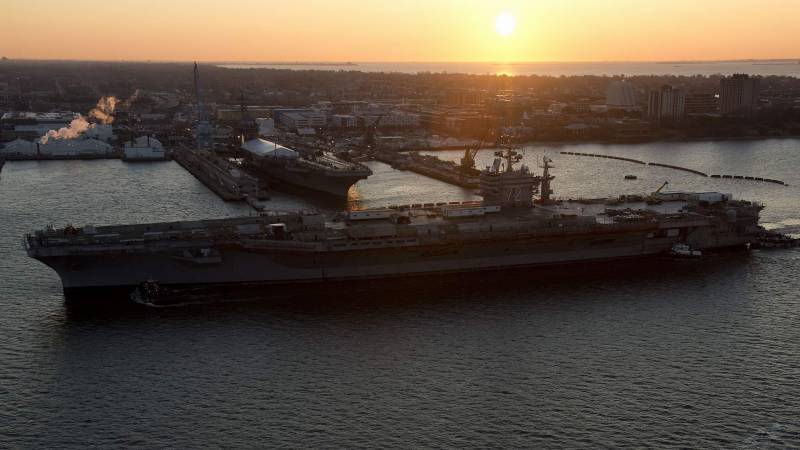
USS Abraham Lincoln (CVN-72) aircraft carrier before docking at the HII plant. In the background is the USS Theodore Roosevelt (CVN-71). 28 March 2013 g. Photo by US Navy
By 2010, American specialists fleet formed a list of necessary modifications to the ship and chose the contractor of similar works. A $ 2,6 billion overhaul contract was awarded to Northrop Grumman. The direct contractor was Huntington Ingalls Industries (HII) shipyard in Newport News. The work was planned to begin a few years after the completion of the modernization of the ship USS Theodore Roosevelt (CVN-71).
As reported, the ship was supposed to pass the so-called. RCOH procedure (Refuelling and Complex Overhaul - “Fuel Replacement and Complex Repair”). One of the main tasks of the work was the unloading of spent nuclear fuel from reactors placed there during construction, as well as the installation of new fuel assemblies. It was also supposed to replace about 2300 various elements of the ship design, 600 of various capacities and hundreds of other systems. Significant updates, in particular, should have undergone electronic detection, communication and control systems.
The main goal of the overhaul and modernization was to restore the technical readiness of the ship with a certain increase in various characteristics, as well as to obtain new opportunities. In addition, upgrades extend service life. So, after passing the RCOH, “Abraham Lincoln” should have been able to serve another 25 years. The total service life will thus reach half a century.
According to reports appearing before the start of the modernization and shortly after its launch, the main work was to be completed before the end of 2016. In 2017, respectively, the aircraft carrier had to return to service and begin combat service. In the future, due to various circumstances, the deadlines for the performance of certain works shifted, due to which the original schedule was disrupted. As a result, the repair was completed only at the beginning of 2017, and the timing of the return of the ship to the Navy has shifted accordingly.
The USS Abraham Lincoln (CVN-72) ship was put on the dry dock of the HII plant in the spring of 2013 of the year. In this work started with some delay. At the time, the administration of President Barack Obama promoted the sequestration of the military budget, which, among other things, provided for a reduction in expenditures on naval programs. The warlords still managed to defend the aircraft carrier modernization program, but the work on updating the next ship began about a month and a half after the initial date.
The first stage of the RCOH program meant the installation of the aircraft carrier in a dry dock and its preparation for further work. After fixing the ship on the factory site, the dismantling of various structural elements, no longer needed and replaced systems, etc. began. In addition, nuclear fuel was replaced. Having completed the dismantling of the specified units, the specialists of the contractor began to install all the required products, systems, etc. It is noteworthy that during such a repair, the Abraham Lincoln received not only new systems, but also an updated superstructure. In order to be able to install a number of new equipment, the upper part of the “island” has been significantly rebuilt.
In early May 2014, Huntington Ingalls Industries reported on the completion of the installation of the largest of the new structural elements provided for by the modernization project. The ship received an improved section of the superstructure, accommodating its upper tiers. In place of the old tiers, a structure was installed that was 88 feet long (almost 27 m) and 32 feet wide (less than 10 m). Most of the internal volume of the new section of the superstructure was given over to the modernized deck control post aviation and its equipment. In addition, there were placed some antenna devices and other equipment necessary for solving special problems.
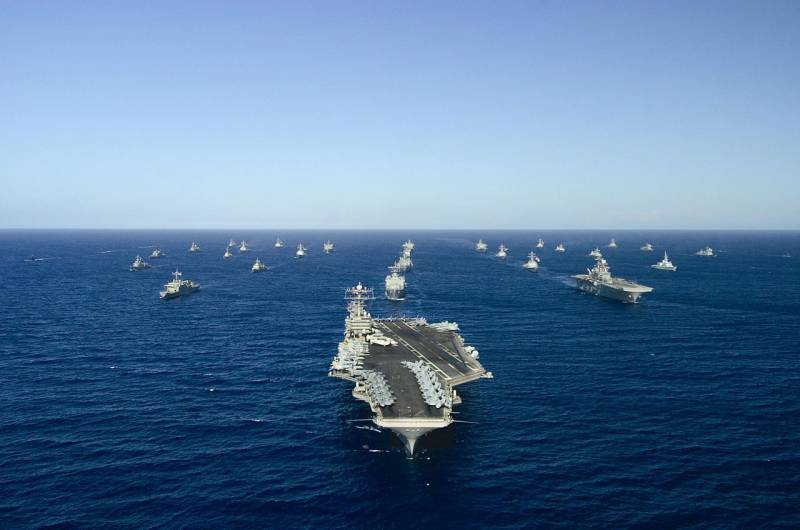
The aircraft carrier USS Abraham Lincoln (CVN-72) and other ships involved in the RIMPAC-2006 maneuvers. Photo by US Navy
After the installation of the new section, the restructuring of the “island” continued. The aircraft carrier superstructure also received a new 38 ft mast (11,6 m), designed to install various antennas, radar stations, etc. Mast installation work completed by mid-August 2014. The completion of this ship rebuilding phase was announced as the most important milestone in the entire RCOH program.
Completion of the formation of the superstructure and its mast allowed to begin the installation of the necessary radio-electronic systems. So, until May 2015, the American shipbuilders were engaged in installing various systems from the AN / SPS-48 radar station, designed to monitor the air situation. It was argued that the use of the updated radar will significantly increase the potential of the USS Abraham Lincoln (CVN-72) aircraft carrier in the search for air objects over land and sea, as well as positively affect its fighting qualities.
In parallel with the installation of equipment on the superstructure, modernization of the steam catapults available on the flight deck was carried out. According to the reports of the end of May 2015, the upgrade of these units was completed by installing covers that protect the underdeck devices as well as ensure the correct movement of moving parts.
It is noteworthy that the steam catapult update was completed long before the end of all other work, and it was decided to test these systems right in the dry dock. In December 2015, the crew and specialists of the shipbuilding enterprise launched all the necessary electrical, hydraulic, pneumatic and steam lines connected with the catapults, and then proceeded to checks. Since December 7, a series of “shots” have been carried out without any load in the form of an airplane or its equivalent. During December and January, gradually increasing the number of launches in the series and reducing the interval between them, we managed to get the required results. At the end of the no-load test, the catapult did a series of up to 20 launches with interruptions of less than 5 minutes, which meets the basic requirements for such equipment.
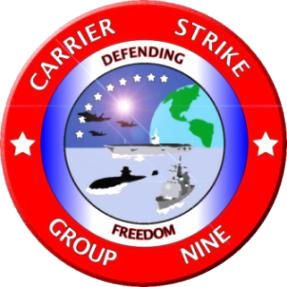
The emblem of the 9 th carrier strike group, in which Abraham Lincoln served before the modernization. Figure US Navy
At the end of 2015, preliminary inspections of other onboard systems installed on the USS Abraham Lincoln aircraft carrier (CVN-72) were launched during the repair. In parallel with them continued installation of other equipment. All the required works were officially completed only a few weeks ago, after which the HII plant began preparations for the return of the ship to the sea. The aircraft carrier was taken out of the dry dock and prepared for the first test trip before returning to service.
On May 9, the ship left its own port of the shipbuilding enterprise and set out on the first hike after the upgrade, the purpose of which is to check the operation of all systems. In accordance with the announced plans, the Abraham Lincoln was to stay at sea for only four days and return to Newport News by the end of the week. During this time, the crew had to restore their skills in controlling the ship, as well as to identify the existing shortcomings, if any.
In the near future, the aircraft carrier must undergo all necessary checks and, if necessary, minor repairs in order to correct the identified shortcomings. After that, he will be able to return to the US Navy. Prior to being sent to the RCOH, the USS Abraham Lincoln (CVN-72) served as part of the carrier group Carrier Strike Group 9 belonging to the 3 of the United States Pacific Fleet. The base of the group is the port of San Diego (pc. California). Apparently, the repaired and “refilled” ship will again be part of the 9-th AUG.
According to reports, as a result of the modernization of the American ship can continue its service, as well as use some new features. Replacing the fuel will allow it to remain in service until the beginning of the 1950s, without the need for a major overhaul or installation of fuel assemblies. In the future, the ship will probably be simply decommissioned and disposed of due to moral and physical obsolescence. According to current plans, existing aircraft carriers such as Nimitz need only one RCOH procedure for the entire service.
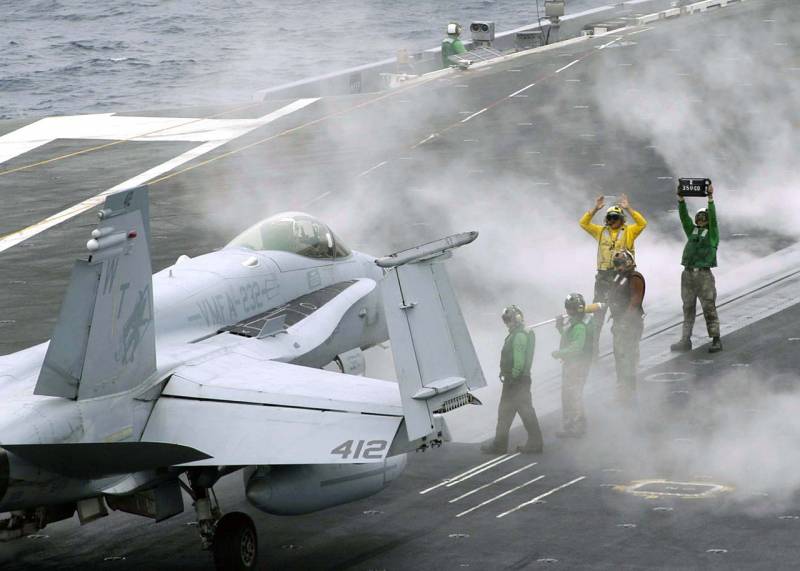
Preparing for takeoff of the F / A-18C fighter from the deck of an aircraft carrier, 26 August 2004. US Navy Photo
Onboard communication and control systems have undergone extensive modernization. Now only modern devices are used that fully meet current and future requirements. As a result, the ship receives new opportunities in finding targets, transmitting and receiving data, organizing attacks, coordinating ship group actions, etc. The potential for detecting a variety of targets is enhanced by newer radar systems.
A notable part of the innovations foreseen in the modernization project concerns equipment intended for the operation of an aviation group. In an updated form, the ship USS Abraham Lincoln (CVN-72) retains the ability to transport aircraft of various classes and types to 90. Internal hangars, lifts, etc. remain in place. In this case, it is now proposed to use newer systems of control, flight control, etc.
According to the available data, at the first time after the return of the ship to service, the basis of its aviation group will be deck fighters-bombers of the F / A-18 family, designed to directly solve basic combat missions. At the same time, in the future, "Abraham Lincoln" may become the bearer of a newer technology.
Thanks to the installation of modern controls for the operation of aviation, the ship will be able to use the latest deck aircraft F-35C Lightning II. Machines of this family are already mass-produced and handed over to customers. In the foreseeable future, the first formations should be formed, equipped only with deck fighters of the latest model. Of particular note is that the USS Abraham Lincoln (CVN-72) was the first American aircraft carrier to receive all the capabilities for the home base of the F-35C aircraft.
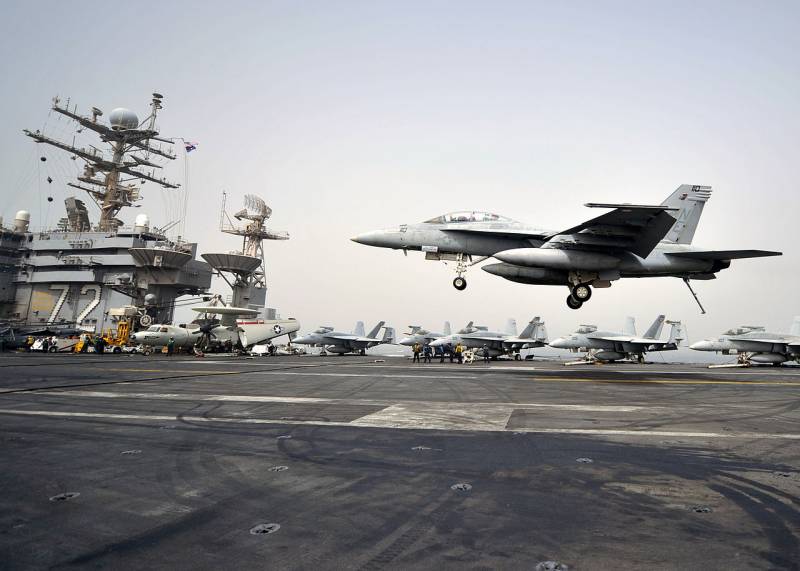
F / A-18F aircraft landing on the deck of the USS Abraham Lincoln (CVN-72), 18 in March 2012. US Navy Photo
Despite the renewal of the design and installation of the new equipment, the ship, in general, retained its main dimensions, displacement and running characteristics. The ship's length still exceeds 332 m with a maximum width of 76,8 m. Draft is about 11-12 m. Full displacement is slightly less than 106 kt. The ship can reach speeds using two Westinghouse A4W nuclear reactors, four turbines and four propellers. more 30 nodes. The range of navigation in practice is not limited by anything. The crew consists of 5680 people: 3200 control the aircraft carrier, the rest are responsible for the operation of aircraft.
C 2013, the shipyard Huntington Ingalls Industries was engaged in the repair and modernization of one of the remaining aircraft carriers in the ranks. About four years were spent on the work ordered by the naval forces, 2,6 billion dollars and 2,5 million man-hours. As a result of such complex, long and expensive work, the ship will be able to serve for a long time, and also will receive new opportunities. In the future, other American aircraft carriers such as the Nimitz will be able to undergo a similar modernization, which will lead to a corresponding increase in the potential of the fleet and its main strike component in the person of AUG.
On the materials of the sites:
http://public.navy.mil/
http://naval-technology.com/
http://globalsecurity.org/
http://armyrecognition.com/
http://nevskii-bastion.ru/
http://uscarriers.net/
http://militaryparitet.com/
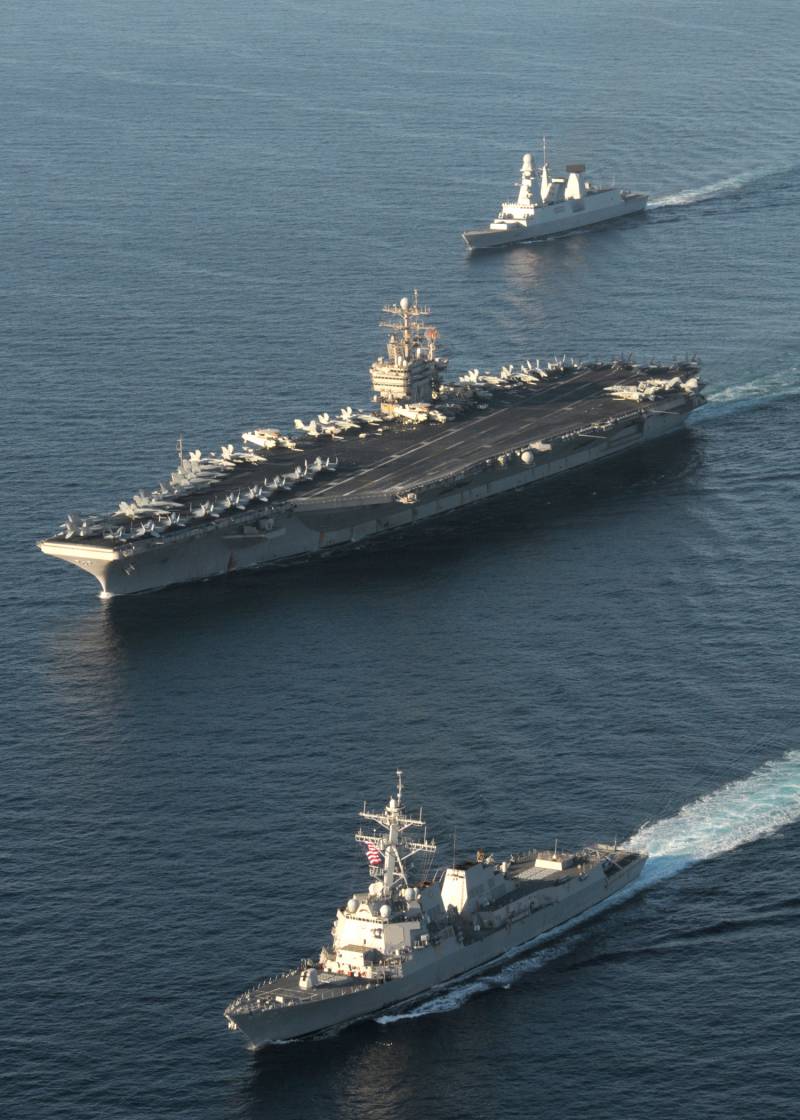
Information